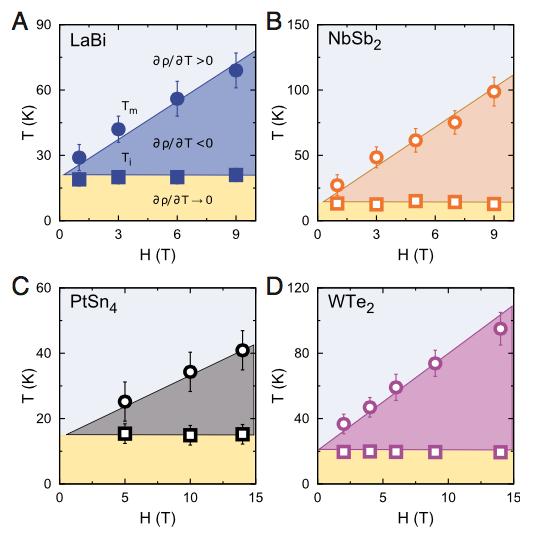Underlying connection found between diverse materials with extreme magnetoresistance

Resistance-temperature-applied-magnetic-field diagrams of materials exhibiting extreme magnetoresistance are shown. Credit: Cava lab
A new study from the Cava lab has revealed a unifying connection between seemingly unrelated materials that exhibit extreme magnetoresistance, the ability of some materials to drastically change their electrical resistance in response to a magnetic field, a property that could be useful in magnetic memory applications.
“The chemistry of these materials looks completely different but they're connected on a profound level by their physics,” said Robert Cava, the Russell Wellman Moore professor of chemistry and corresponding author on the work published in the Proceedings of the National Academy of Sciences.
Numerous materials with extreme magnetoresistance have been reported since the Cava lab first discovered extreme magnetoresistance (originally named 'large magnetoresistance' by Nature editors before the research field supplanted it with the current term) in WTe2 two years ago.
But in particular, researchers in the Cava lab noticed that five materials with extreme magnetoresistance yet very different structures and chemical make-up all share the same characteristics when their resistance-temperature-applied-magnetic-field diagrams are measured. This diagram maps the temperature and magnetic field strength at which the material's magnetoresistance turns on and then saturates. Using the phase diagrams as a clue, scientists may be able to identify other materials with extreme magnetoresistance.
Detailed investigations by Fazel Tafti, a former Cava lab postdoc and physics PhD, revealed a common feature related to the materials' electronic structures, leading the researchers to propose a picture of the underlying physics that unifies these chemically disparate materials. This kind of research, where materials chemistry and materials physics meet, is what the Cava lab and its collaborators enjoy the most, Cava said.
“Now we hope that other people will think about this, and make more measurements to see whether our proposal for the unifying physics holds up to more intense scrutiny,” Cava said. He was confident that first author Fazel Tafti, now an assistant professor of physics at Boston College, would get to the bottom of this phenomenon. “Physicists quest for truth,” he said.
###
Read the full article here:
Tafti, F. F.; Gibson, Q.; Kushwaha, S.; Krizan, J. W.; Haldolaarachchige, N.; Cava, R. J. “Temperature-field phase diagram of extreme magnetoresistance.” Published online before print June 7, 2016.
This research was supported by the Gordon and Betty Moore Foundation under the EPiQS program, Grant GBMF 4412 and the ARO MURI on topological insulators, Grant W911NF-12-1-0461.
Media Contact
All latest news from the category: Materials Sciences
Materials management deals with the research, development, manufacturing and processing of raw and industrial materials. Key aspects here are biological and medical issues, which play an increasingly important role in this field.
innovations-report offers in-depth articles related to the development and application of materials and the structure and properties of new materials.
Newest articles

Superradiant atoms could push the boundaries of how precisely time can be measured
Superradiant atoms can help us measure time more precisely than ever. In a new study, researchers from the University of Copenhagen present a new method for measuring the time interval,…

Ion thermoelectric conversion devices for near room temperature
The electrode sheet of the thermoelectric device consists of ionic hydrogel, which is sandwiched between the electrodes to form, and the Prussian blue on the electrode undergoes a redox reaction…

Zap Energy achieves 37-million-degree temperatures in a compact device
New publication reports record electron temperatures for a small-scale, sheared-flow-stabilized Z-pinch fusion device. In the nine decades since humans first produced fusion reactions, only a few fusion technologies have demonstrated…





















